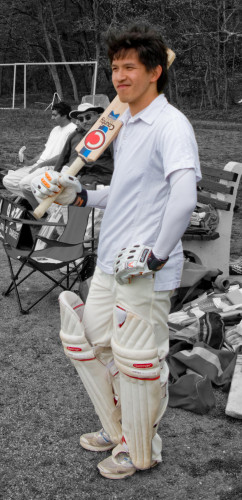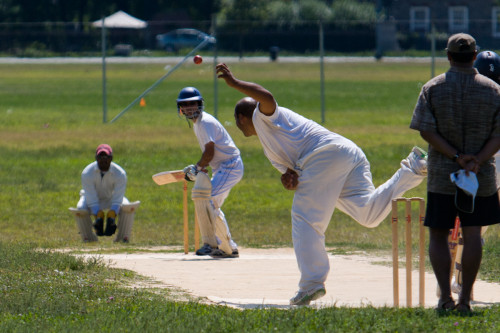Cricket
With the ICC Cricket World Cup under way, I thought this would be a good time to write an article about cricket for the benefit of my friends who are not familiar with the game. With any luck I will be able to communicate a basic understanding of the game, and perhaps even a bit of appreciation for the various skills and difficulties associated with it. At the very least, I hope that my friends will be able to understand the occasional facebook status update about results from the world cup. Cricket is often confusing to newcomers because (in typical English fashion) the nomenclature of the game is strange, and many words have more than one meaning depending on the context.
Cricket is a very old bat-and-ball game that originated in England. It is popular in England, and is considered by some to be the national sport. When the British Empire was at its peak, it spread the game throughout the colonies, and it is therefore no surprise that the world’s strongest cricketing nations are former British colonies. I first played it as a schoolboy in Hong Kong, although curiously enough I hardly played it while I lived in Australia (where it is one of the most popular summer sports). I briefly played for the Columbia University Cricket Club when I lived in New York.
There are various variants of the sport which are most easily distinguished by the length of time it takes to complete a game. At the very top, there are “test matches” which last up to five days – this is the highest form of the game. It is also the least-understood form of the game. The other two most common forms are “One Day Internationals” (ODIs) and “Twenty20”. ODIs, as the name suggests, last for about one day and consist of one innings of 50 overs per side. Twenty20 is basically identical, except with only 20 overs per side and they generally last just over three hours.
Basic Rules
The game is played on an oval-shaped grass field with no fixed dimensions. The boundary is marked by a rope, and the middle is dominated by a 22-yard rectangular pitch called the wicket. At either end of this rectangular pitch stand three vertical bits of wood which are called stumps (sometimes also called wickets) across the top which are placed bails. During the game, the batting team will have two batsmen batting, standing at either end of the wicket, while the fielding side will have their full team of 11 players in the field.
The object of the game is to accumulate a higher number of runs than the other team. A run is scored when the two batsmen swap ends after a ball is bowled (most often after one of the batsmen has hit it). If a ball is hit and reaches the boundary it is automatically counted as four runs, if it passes the boundary without touching the ground, then it is counted as six runs.1 Runs are also awarded for wides (when the ball is bowled outside a certain area) and for no-balls. No balls also result in the ball having to be bowled again. These extra runs are called “extras”.
A bowler (like a pitcher) will take a run up to one end of the rectangular pitch and then bowl a ball overarm towards the other end in the general direction of one of the batsmen. This happens six times in an over after which a different bowler will bowl the ball from the other end towards the other set of stumps. The objective of the bowlers is to remove the batsmen by getting them out while simultaneously limiting the number of runs.
There are many ways of going out in cricket. If the ball is hit, then caught before it touches the ground, then the batsman is out (this includes if it skims the edge of the bat, and then is caught by the wicket-keeper). If the batsman is outside his crease (a line 4 feet in front of the wicket) and the ball touches those bits of wood such that the bails are dislodged, then he is out. If this happens right after he has been bowled to, then he is “stumped”, if it happens while the batsmen are swapping ends in the process of scoring a run, then he is “run out”. If a ball is bowled, and the batsman misses it and it carries through to the wickets and dislodges the bails, then the batsman is “clean bowled”.
In a typical innings, the bowlers will continue bowling balls at the batsmen until either all of the batsmen are out, or a predetermined number of balls are bowled. (In a test match where there are, in principle, unlimited overs, there exists an additional option to declare – to end an innings before all the batsmen are out, which can be important strategically).
Hopefully the above explanations have given you a basic understanding of the mechanics of the game, so if you catch it on TV it won’t just look like a bunch of guys standing out in a field getting sunburnt.
Basic Strategy
A well-rounded team will generally consist of 5 batsmen, 5 bowlers, and a wicket-keeper. Of course, at high levels of cricket, most of the players are decently capable of playing any position, but they will usually specialize in one aspect of the game. Players who are talented at batting and bowling are called all-rounders and are quite rare, and valuable players to have for obvious reasons.
A cricket ball is made from cork and is covered in leather, with a seam stitched around its equator. This gives bowlers all manner of devious ways in which to get a batsman out. This is generally what happens:
At the start of the innings, the ball is new and due to aerodynamics will move through the air faster. In the early overs of an innings the type of bowling primarily employed is that of the fast variety (typically 130+ km/h). Like fast serves in tennis, and fastballs in baseball, these are difficult for batsmen simply because they are so fast that they give batsmen less time to react to the delivery, making it difficult to score runs and also making them vulnerable to going out. Fast bowling is also psychologically intimidating, with bowlers sometimes deliberately bowling a ball to bounce into the body of a batsman to unsettle him.
As the game progresses, the ball becomes worn. However, a good fielding side will take care to keep one side of the ball more “polished” than the other. This has the effect of making the ball swing in the air. A ball coming at a batsman at 130 km/h AND changing path through the air presents obvious problems for his run-scoring agenda. Then there’s the added unpredictability of the bounce if the ball lands on the seam.
After a while the ball becomes really worn, and it is difficult for the fast bowlers to get the same speeds as they did at the start of the innings. The fast bowlers also get tired. The roughened surface of the ball allows for another kind of bowling to be used effectively – spin. The principle is simple enough – bowl the ball down the wicket and spin it so that it changes direction on the bounce. Being consistently accurate with spin delivery is difficult though, and a poorly-executed spin-ball, because of it’s lower speed, may be struck more easily by a batsman. Effective spin bowling (see below) however, with its unpredictability both in the air, and off the bounce can be used to devastating effect.
On the receiving end of all this are the batsmen. Unlike in baseball, where the ball must be hit within a certain area, a ball may travel anywhere after striking a cricket bat. Glancing shots which use the pace of a fast bowler more than the momentum of the cricket bat are common. Typically the best batsmen are sent to bat first because, even though they have to face the brunt of the fast bowling attack, they also get the opportunity to face more balls because if they are later in the order, then there is a chance that they may run out of time in which to score runs.
Good batsmen are usually not only very coordinated with hitting a ball with a bat, but also have very quick reflexes to react to inconsistent bounces, or the swing of a fast ball. It is widely rumoured that legendary batsman Donald Bradman practiced by hitting a golf ball with a cricket stump against a sheet of corrugated iron to hone his reflexes.
The currently in-progress Cricket World Cup consists of a tournament of one day matches. In an ODI, a coin is tossed and the winner of the toss decides whether he wants his team to bat or bowl first. The decision can be a very important one because the condition of the wicket changes throughout the day. As the ground gets pounded by cricket balls it slowly becomes rougher and the bounce more unpredictable, or so the theory goes. Other factors to consider include the moisture in the ground (the ball rolls faster on dry hard ground, making boundaries slightly easier), and even changing weather conditions (although that is more a consideration for 5-day test matches).
Understanding the Numbers
Cricket is a sport that lends itself very readily to statistics. While I could go on for many more articles on the various cricket stats that I have committed to memory, here I will try to construct a rough guide to understanding the reports that might come out in the news relating to the current world cup.
Let’s begin with the match report from the recent game between Pakistan and Sri Lanka:
“Pakistan 277/7 (50 ov); Sri Lanka 266/9 (50 ov) – Pakistan won by 11 runs”
277/7 (two hundred and seventy seven for seven) is something you’ll often hear in a quick news report, and sometimes the big and small number is swapped. The side who bats first appears first. The big number is the number of runs. 277 is a decent score, especially considering that these are two very good, well-rounded teams playing each other. In an ODI, each side bowls 50 overs, which is 300 balls. The small number is the number of wickets lost. Every time a batsman goes out, it is called a “wicket” (remember my earlier point about confusing nomenclature?). So this means that Pakistan scored 277 runs, and in doing so seven batsmen went out. The number in brackets, not always present on result reports, is the number of overs. In this case, both teams reached the end of all of their overs and the winning side easily determined by counting the runs. This was a relatively close game with both teams having to “use up” all their balls before a result could be determined. The theoretical maximum number of runs per over is 36, and scores of 10 per over are not unusual, especially in the final overs of a game.
Now a different situation:
“Bangladesh 58 (18.5 ov); West Indies 59/1 (12.2 ov) – West Indies won by 9 wickets (with 226 balls remaining)”
The 58 with no number after it indicates that Bangladesh were “all out” for 58 runs (you could write 58/10, but that wastes ink). In this game the West Indies were able to bowl out the entire Bangladeshi team for only 58 runs on the 5th ball of the 19th over. Either the “windies” were having a very good bowling day, or Bangladesh were having a shocker of a batting day, though I suspect both factors conspired to create this result. The windies had no trouble chasing the total, and achieved this on the 2nd ball of the 13th over for the loss of only one wicket (so only one guy went out). When there is a successful run-chase, the margin of victory is not the number of runs (because who knows how high a total the winning team could have achieved) but instead is the difference in number of wickets taken by each team. The number of balls remaining is not always included.
Ok, lets have a look at a typical line on a scorecard:
| 1 . . 4 . . | . . 4 . 2 . | 1 . . W . nb . | . . 1 . . 2 | . . . . . . |
The numbers are the number of runs. The dots are just our lazy way of writing zero. This is where the term “dot ball” comes from. When a bowler bowls a dot ball, it is well-executed enough to prevent the batsman from scoring any runs. The big “W” means wicket, indicating that a batsman is out, and “nb” is short for “no ball”. Notice that no runs were scored during the last over – this is called a “maiden” over.
Batting stats are fairly easy to understand. There’s the batting average, which is the average number of runs that the batsman scores per wicket. This means that if a batsman somehow manages to get through a bunch of games without going out (he could still be “in” when the game runs out of overs, or he could be the unhappy half of the final pair when the last guy goes out). When you think about batting averages as being per wicket, although almost superfluous for batting, it helps us understand bowling stats.
Sometimes a brief match report will take the form:
Australia 262 for 6 (Watson 79, Clarke 58*, Mpofu 2-58) beat Zimbabwe 171 (Cremer 37, Johnson 4-19, Tait 2-34) by 91 runs
The names in brackets are “highlight” performances. So in th Australian batting innings, Watson scored 79 runs, and Clarke 58 runs not-out (that’s what the asterisk means). In the same innings, Mpofu (a bowler from Zimbabwe) gave away only 58 runs, for two wickets.
The other major stats that get bandied about are a batsman’s “strike rate”, which is simply the percentage of runs-from-balls that a batsman makes, and a bowler’s “economy” is the number of runs he gives away per wicket.
So hopefully this has given you a good overview of the game of cricket and will help you understand and enjoy the cricket world cup and any subsequent cricket games you might find yourself watching.

Getting ready to bat for the Columbia University Cricket Club. I went out for a "duck" that day (0 runs)
Footnotes
- This was corrected from a previous version of the article that stated that the ball must not touch a fielder. The ball may touch a fielder and still be counted as a six, if the fielder drops the ball over the boundary. ↩



It’s always good to see someone provide a useful public service in helping teach the uneducated masses about cricket. The minituae of the article though does out you as not being quite the hardcore cricket fan.
I should make an effort to not nitpick too much, especially since I approve of the content on general terms. So I just will give a sample observation.
For example your definition of a six is wrong. The condition for a six is to pass the boundary without touching the playing surface. Whether or not it touches a fielder en route is irrelevant. Thus it is possible to drop a catch, and concede a six in the process. For example, this happened off Jo Angel’s bowling while he was delivering his first over in test cricket.
I was wondering about the definition of a six actually… because I had an experience while playing in Hong Kong where I was fielding on the boundary and dove for a ball but only managed to get my fingertips to it before it went over – and it was only counted for 4. If I ever see the scorekeeper for that game, I will let him know of his error.
Thanks for pointing it out, the article has been corrected.
Please do continue to offer corrections.
Nice expose Yeowie ! I think its also a six these days when the fielder catches the ball and then runs over the rope, happens sometimes.
You should note that in Australia, the score is always read as 9/277 not 277/9 ie ninfa 277, not 277 fer nine – always causes some concern here when the score is 0/3 and its read as 3/0 !!!
I would also suggest that the pitch is what you play on, its not so much called \”the wicket\” but in typically quirky circumstances it could be classed as a \”turf wicket\” – in general, the wicket would be more thought as the stumps rather the pitch e.g. LBW is leg before wicket and not LBS if you get my meaning.
Good job!